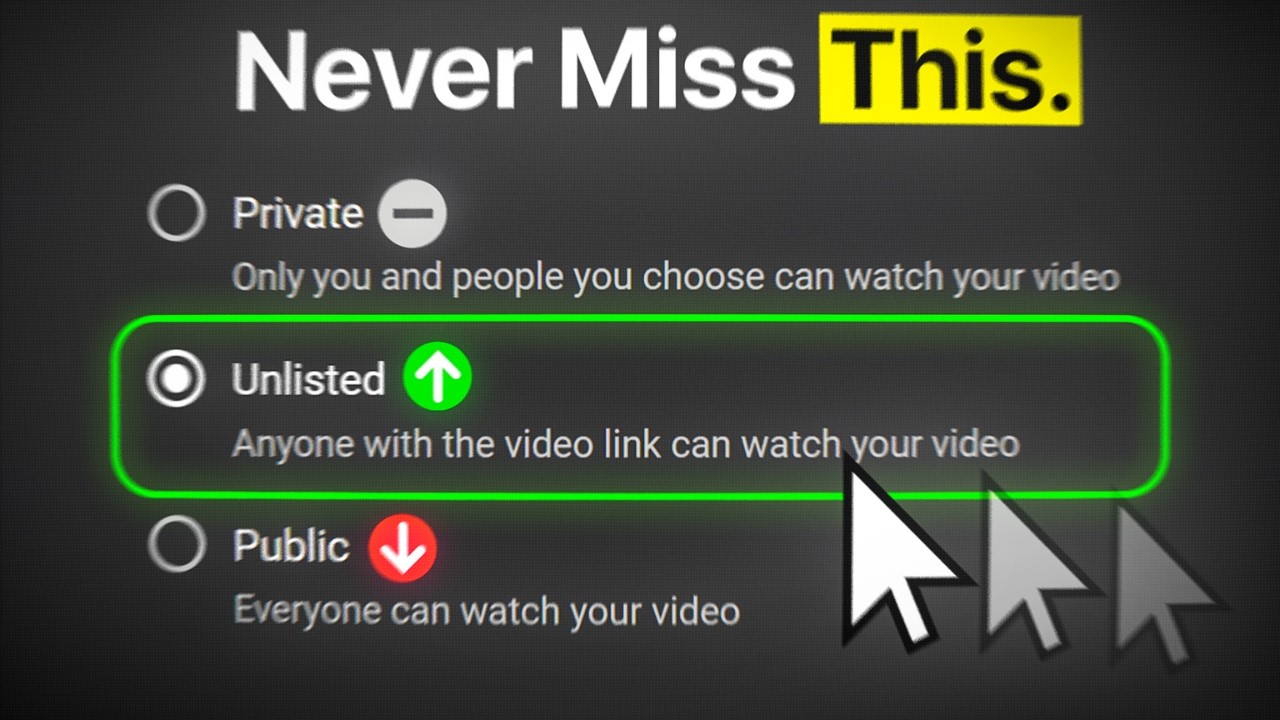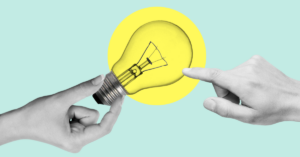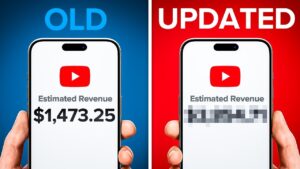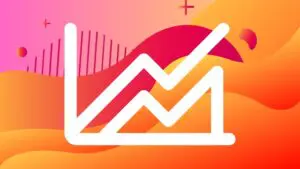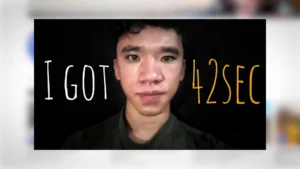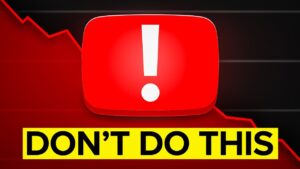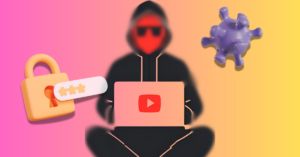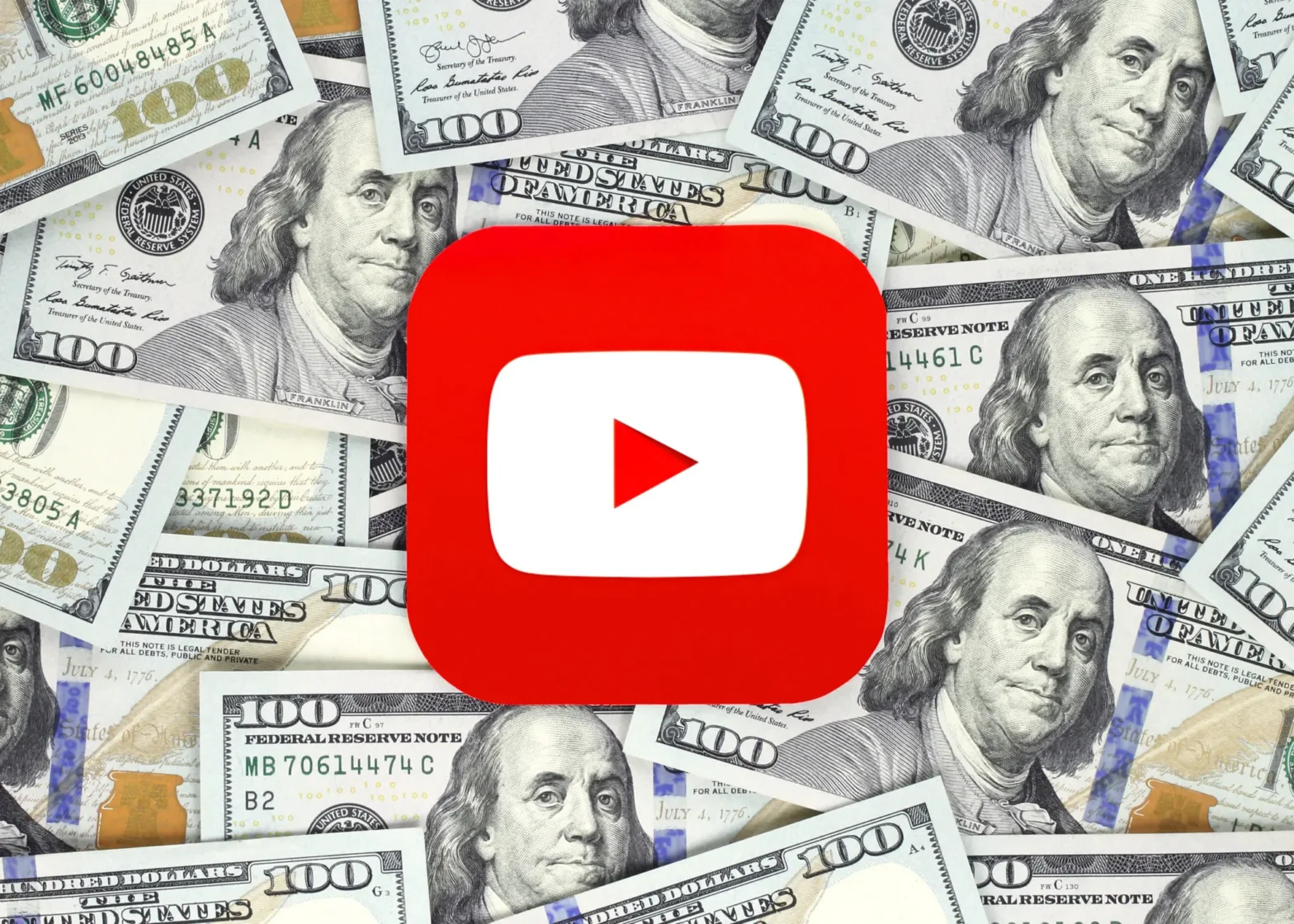Passion may be what starts you on your YouTube journey but understanding YouTube monetization requirements in order to make money from your content is what will keep you going.
YouTube monetization requirements go beyond just watch time and the number of subscribers a channel has. However, those two things, watch time and subscribers, are the biggest milestone.
YouTube Monetization Requirements: Views and Subs
To fully monetize your channel and get a cut of ad revenue, you need to have:
- 1,000 subscribers
AND - 4,000 hours of watch time across all your videos over the last 12 months
OR - 10 million Shorts views over the last 90 days
Read our post on how to get 4,000 hours of YouTube watch time.

YouTube added a lower monetization tier that gives creators access to fan funding and some other features but not a cut of ad revenue. To qualify you need to have:
- 500 subscribers
AND - Three public videos uploaded in the past 90 days
AND - 3,000 hours of watch time across all your videos over the last 12 months
OR - 3 million Shorts views in the last 90 days
Check out our post on how to get 3,000 hours of YouTube watch time.

These are the basic requirements for joining the YouTube Partner Program (YPP) and getting your channel monetized. We’ll get a little deeper into these requirements later in this post. However, these are not the only considerations and even if a creator hits the eligibility targets, it’s no guarantee they’ll be invited to join the YPP.
So with that in mind, let’s go through all of the YouTube monetization requirements to make sure you’ll be able to join.
#1 YouTube monetization requirement: Location, location, location
The YPP is available in many countries, but not all. First things first, confirm that you reside in one of the countries eligible for YouTube monetization.
Get an unfair advantage on YouTube
Give your YouTube channel the upper hand and easily optimize for more views, more subs, and more of every metric that matters.
#2 YouTube monetization requirement: Be good
If you’re making original content and you’re not trying to game the system, you’ll be fine. If not though, YouTube can (and will) shut your channel down. The short version is this: your content needs to be “authentic” and “original,” and it needs to be “advertiser friendly.“
It’s definitely worth reading through the YouTube channel monetization policy support article. And if that’s not enough reading for you, you should also at least skim the following documents:
#3 YouTube monetization requirement: Strike one you’re out?!
YouTube doesn’t play around when it comes to its Community Guidelines. If you get three strikes, you’re off YouTube but even a single strike can keep you from monetizing your channel. For most offences, especially accidental offences, you’ll get a warning. In some cases, you can address the concern and get rid of the warning. Warnings shouldn’t keep you from monetizing but it doesn’t pay to take chances.
Remember that the rules in the YouTube Community Guidelines apply to every channel, from the biggest to the smallest. If you follow the rules, you’re good. If you don’t, YouTube could drop the hammer at any time.
#4 YouTube monetization requirement: An AdSense account:
You need to have an AdSense account linked to your YouTube channel in order to get paid out. Creating an AdSense account and linking your AdSense account to your YouTube channel isn’t hard. It only takes about 10 minutes.
Best to have this step completed before you even apply to monetize your YouTube channel.
#5 YouTube Monetization requirement: 2FA
Two-factor authentication (2FA) adds an additional layer of security that makes it more difficult for somebody to take over your account. In order to be eligible to monetize your channel, you need to turn on two-factor authentication on YouTube. Or more accurately, you need to turn on 2FA on the Google account associated with your YouTube channel.
YouTube monetization requirements: Subscribers and watch time
We talked about the number of subscribers and the watch time or Shorts views required to start monetizing your YouTube content. Let’s refresh on those numbers and get a little more context.
Start Making Money on YouTube with Just 500 Subscribers
In 2023, YouTube lowered the bar for entry to the YPP by offering an earlier or reduced access route. To qualify, YouTube creators will now only need:
- 500 subscribers
- Three videos published publicly in the last 90 days
- Either 3,000 watch hours in the past year OR 3 million YouTube Shorts views in the past 90 days.
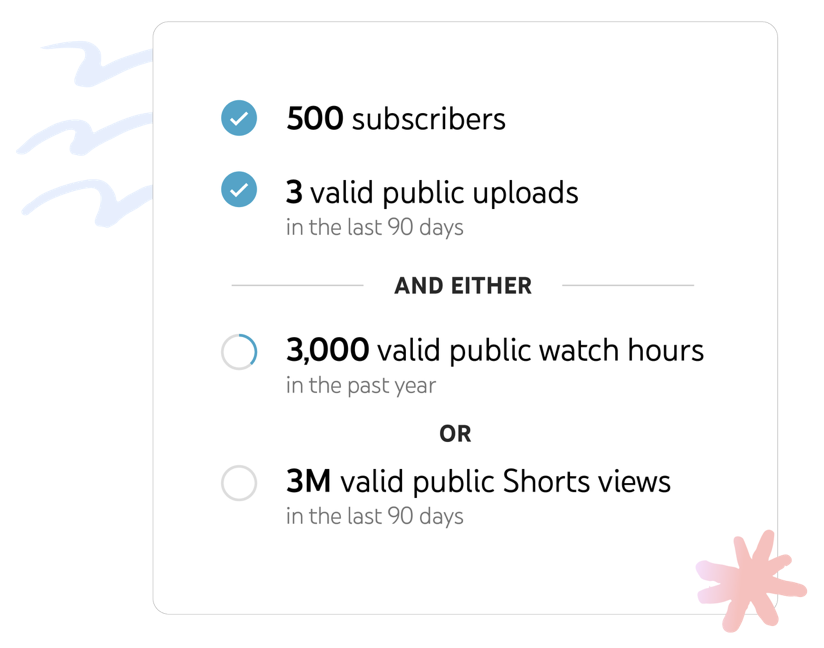
Creators with 500 subscribers won’t be able to make any revenue from ads run against their content just yet, but once their channel is initially accepted into the scheme, they can earn money from fan funding features such as:
- Channel memberships: to offer premium content and member perks to viewers who pay a monthly fee
- YouTube Shopping: select YouTube Shopping features to tag products available for sale in videos
- Super Chat and Super Stickers: to offer your fans the ability to highlight their message within a live chat or to get an animated image that pops up in the live chat
- Super Thanks: generate revenue from viewers who want to show extra thanks for your content
YouTube Shopping is an interesting opportunity. If you’re thinking of releasing your own branded products, take a look at our ‘4 Steps to a Successful Merch Strategy‘ post.
The earlier access route is great news for smaller channels. Going from 500 to 1,000 subscribers isn’t always easy, and it’s encouraging to see YouTube opening up the options for smaller or newer channels to earn something from the platform before their channel can be fully monetized. Learn more about the early access YPP in this video:
Unlock AdSense revenue with 1,000 YouTube subscribers
To generate revenue from ads and from YouTube Premium, as well as merch and fan funding, YouTube channels will need to hit the following targets:
- 1,000 subscribers and 4,000 hours of watch time in the last 12 months OR
- 1,000 subscribers with 10 million valid public Shorts views in the last 90 days
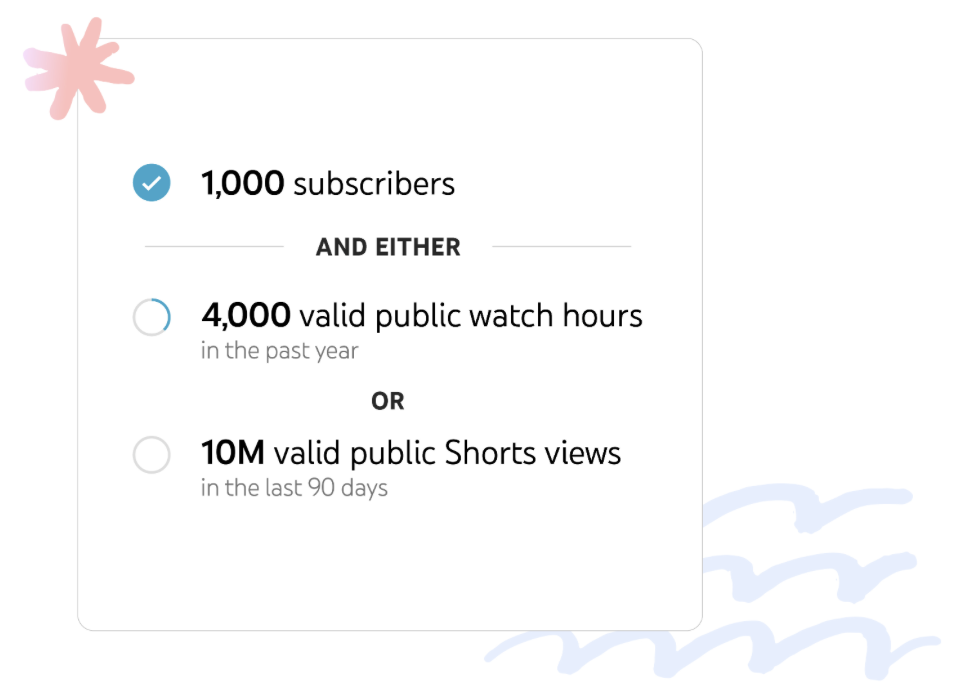
The reward for reaching these goals is a share in the revenue from ads that run against your videos. The different ads currently include display, overlay, non-skippable, and mid-roll placements.
YouTube Premium users don’t see ads and since ad views = revenue for YouTube creators, it may be good for viewers but it sucks for creators. Eligible creators in the YPP will also benefit from the YouTube Premium membership scheme to earn a share of the Premium subscription fees based Premium subscriber views on their videos.
How to generate 4,000 hours of YouTube watch time
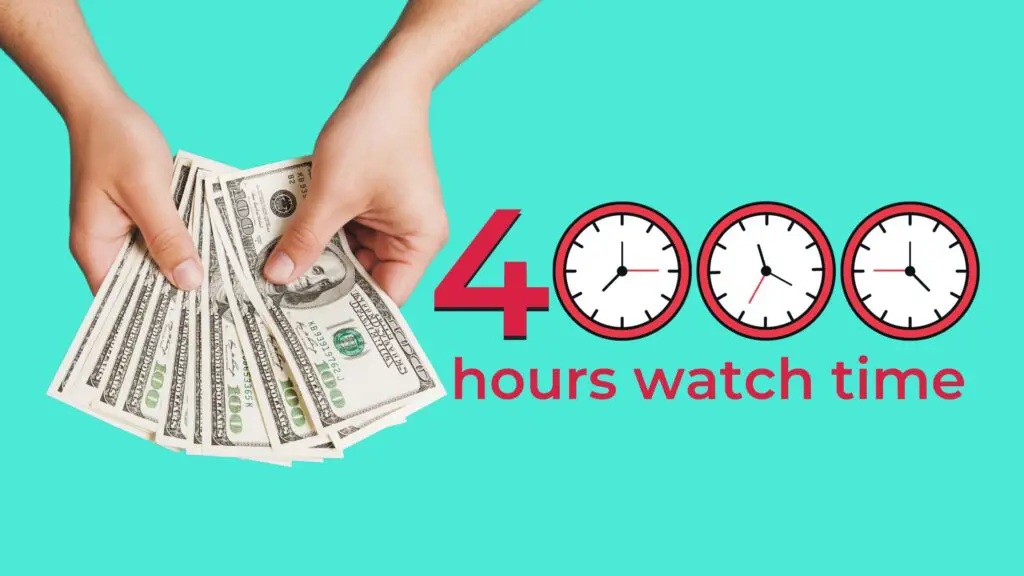
If you want to start earning ad revenue, your channel will need to have generated 4,000 hours of YouTube watch time over the past 12 months and have at least 1,000 subscribers.
This goal is very attainable if you consistently publish engaging content and aim to build an engaged subscriber base. If you need some inspiration or encouragement, our 6 Ways to Generate 4,000 Hours of YouTube Watch Time FASTER! will help you meet that goal.
We have a ton of information on the TubeBuddy blog and our YouTube channel to help you grow your YouTube Views and subscribers.
In our post ‘How to Get 1,000 Subscribers on YouTube‘, we have a number of solid tips aimed at smaller channels that want to grow their subscriber numbers. Take a look and start building that foundation for success.
How long before YouTube accepts my YouTube Partner Program application?
Once you’ve hit either the benchmarks and applied for the YouTube Partner Program, the only thing left to do is wait… but for how long? How long does YouTube take to approve (or deny) a YPP application?
Providing YouTube thinks you’re a viable candidate, it says it aims to turn around application requests in around 30 days.
The platform uses a mix of automated systems plus actual humans to review your channel to make sure it fits the criteria. You’ll get an email update but you can also check the ‘Earn’ section of YouTube Studio to see if there’s any news on your status.
Some factors that YouTube says can delay your YouTube Partner Program application include:
- The number of applications that YouTube is dealing with at any one time
- The limits on (human) resources that YouTube is facing
- The number of reviews that your channel warrants
Creators should apply to the YouTube Partner Program as soon as they meet the criteria. Don’t worry if your application isn’t successful on the first try. In this case, the best advice is to keep on uploading quality, engaging, and original content, and re-apply after a 30-day period.
If your second or third application fails, you can keep trying, but you’ll have to wait 90 days between attempts.
Repeat failures indicate that your channel has significantly missed the mark when it comes to the criteria needed to join the YPP. Correct the issues, endure the waiting period, and try, try again.
If YouTube rejects your application multiple times, use the 90 days to generate more watch hours and subscribers. Please remember that these aren’t the only goals though: you’ll need to fully comply with the content and copyright rules, be on the right side of the community guidelines, and have your Adsense account set up and ready to go.
How to stay on the right side of the YouTube partner program
If your application keeps getting turned down, you need to understand what YouTube is objecting to. If you really want to monetize your channel and take advantage of the ad revenue and fan funding options on offer, you have to avoid certain things that YouTube just will not tolerate, as they may offend potential advertisers, including:
- Making controversial or inflammatory statements. Freedom of speech is alive and well on YouTube, but freedom of speech is not freedom from consequences. If you upload content designed to be incendiary, you may end up paying for that decision down the line. Even if content isn’t pulled down, it may be demonetized.
- Excessive swearing: YouTube will let you get away with some swearing (see our post on how a little swearing on YouTube won’t get you demonetized) but excessive profanity can get your channel flagged or your content demonetized.
- YouTube also doesn’t look kindly on “shocking” content. Again, after incidents like the Adpocalypse and the COPPA clampdown, the platform has to keep on the right side of the brands that advertise with it. In this age of social media, brands face a potentially massive backlash if they are seen to be advertising against controversial content, whatever form it takes. YouTube would rather avoid any scandals by nipping the problem in the bud and not allowing repeat offenders into the Partner Program in the first place. Be warned.
- You may think you’re being clever if you use a clickbait thumbnail to trick viewers into your watching your content, but along with being punished with low engagement and retention rates, YouTube really doesn’t like this approach and your YPP application may not be successful.
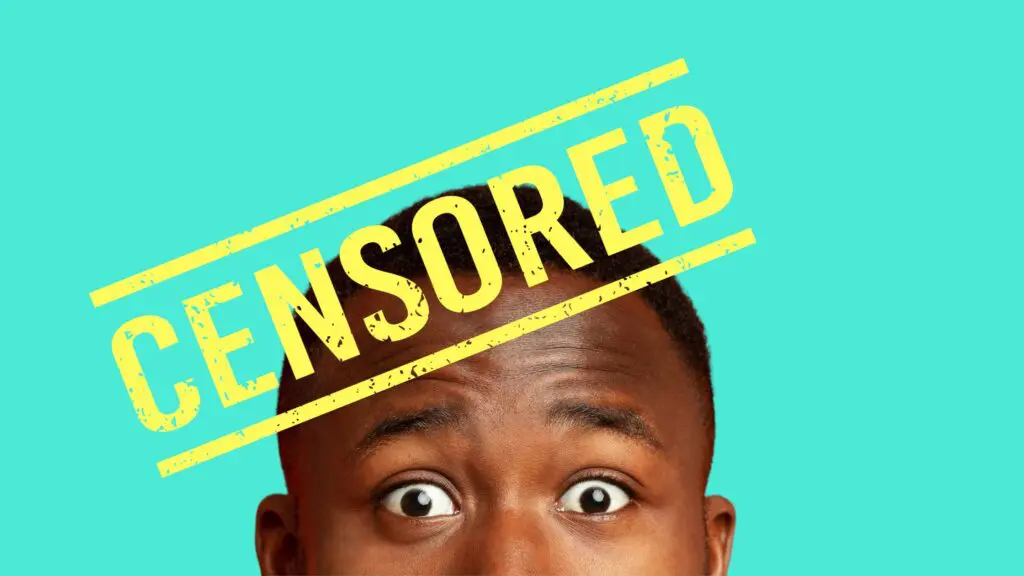
What kind of videos or topics can’t be monetized on YouTube?
Following on from these general guidelines, YouTube is also skittish about the kind of video topics and content it is comfortable in promoting via the Partner Program. It makes its position clear via its Advertiser Friendly Content Guidelines. It’s far likelier that you won’t be accepted (or your access will be removed) if you consistently post about the following
- Overtly graphical or sexual content (i.e. no porn, please)
- Content that pushes dangerous or harmful content that is likely to lead to violence
- Videos that include hateful or discriminatory content
- Videos that depict violence without any added context: News and journalism outlets can report on events that include violence, like warfare or rioting, for example, but non-news sources that post gratuitous violence for the sake of it won’t be monetized.
Stay active on YouTube to keep making money
If you’ve been accepted into the YouTube Partner Program, firstly, congratulations!
It’s a beginning, not an end. The YPP is the business model for YouTube, and it needs to keep it active in order to benefit the platform, the creators, and the brands that advertise with it. If your channel fails to upload a public video or post to the Community Tab for a period of 6 months, then YouTube reserves the right to terminate your access to the Partner Program. Channels will need to reapply if they want to participate again.
If you lose access to the YPP, you’ll lose any passive income you may have been earning from the content you’ve uploaded in the past.
If you’re nearing the six-month deadline, at least start posting to the Community Tab until you can publish brand-new videos or Shorts.
There it is; that’s all the main info you need on how to make money via the YouTube Partner Program. We’ve included links to lots of resources to help you, plus you should jump to Google for the official details on YouTube monetization.
Stay tuned to the TubeBuddy blog, and our YouTube channel and social channels as we bring you all the strategies and tips needed to help you grow your YouTube channel in 2024 and beyond.
Get an unfair advantage on YouTube
Give your YouTube channel the upper hand and easily optimize for more views, more subs, and more of every metric that matters.

